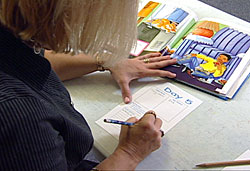
Dialogic Reading is a five day strategy; there is a step for each day of the week. Day 1 can start on whatever day is best for you, however, below you will see that we used a five day sequence starting on Monday and ending on Friday.
![]() As you go through Learning the Strategy, it would be helpful for you
to print out the Quick View document. The Quick View provides a summary
of all the steps within Dialogic Reading.
As you go through Learning the Strategy, it would be helpful for you
to print out the Quick View document. The Quick View provides a summary
of all the steps within Dialogic Reading.
Planning:
- Planning is a critical step. You will look through the book you have chosen for your Dialogic Reading lesson and pick realistic pictures that represent words the children may not be familiar with.
- It is important to remember that Dialogic Reading should be implemented in small groups no larger than six children.
- It is also important for you to plan what the other children will be doing while a small group engages in Dialogic Reading. The other children could be involved in independent centers or other small groups with another adult. There are many options and which one you choose depends on your classroom arrangement.
- Be prepared to offer child-friendly definitions for targeted picture vocabulary.
In the next video, Dr. Phillips discusses the importance of choosing the correct book for Dialogic Reading.
|
Click here to print the transcript of this video, then |
As you continue with Learning the Strategy, a book icon will appear that prompts you to think about your book selection and how to use it with Dialogic Reading. Click on the icon for helpful questions and tips to guide you as you learn this strategy.